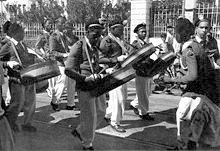Pan Round the Neck Steelbands/ Single Pan Bands
Up until the 1950’s, steel pans were played while hung around the neck of the performer or while being carried in one hand of the performer.
The main function of steel pan at that time was to accompany the street processions of the annual Carnival festivities of Trinidad and Tobago, and so pannists had to be able to walk and play the pan at the same time.

Steelband,Trinidad 1950's.
Picture courtesy of Wikipedia: The Free Encylopedia
These traditional types of steelbands were known as Pan Round the Neck bands in reference to the way the pans were carried.
They have recently been re-branded Single Pan Bands. This is thought to be a more appropriate name as each pannist plays one single pan.
Also, if the occasion does not require the band to be mobile, the pans are hung on stands which make the name pan round the neck redundant.
The Instruments of the Single Pan Band
A typical single pan band usually contains the following instruments:
- Frontline pans - single tenor pans, single seconds, harmony pans
- Mid-range pans -single guitar
- Background pans -4 note bass pan, dudup.
- Engine Room
Advantages of a Single Pan Band
- Single pan bands can be both mobile and stationary
- Less storage, rehearsal and performance space is needed than conventional bands
- Transporting instruments is easier than conventional bands
- The band can be easily integrated with marching bands
Disadvantages of a Single Pan Band
- Choice of keys and ability to modulate is limited.
- Mid-range and background pans cannot do extended solos as they have fewer notes
- The pannist has to bear the weight of the instrument if the band is mobile
- Playing while carrying the pan around the neck requires more coordination and concentration